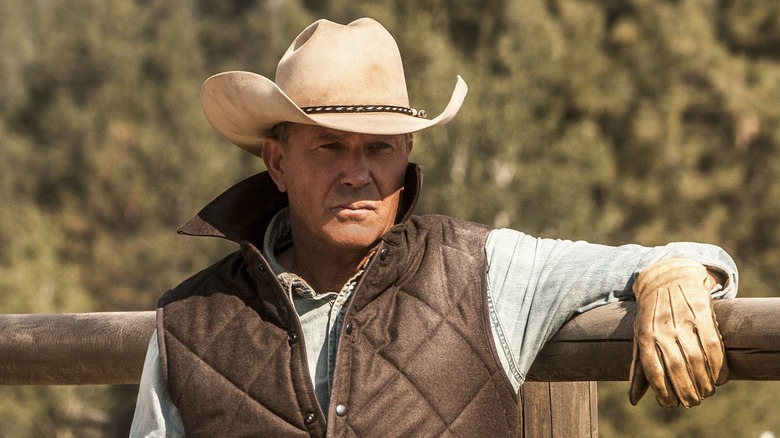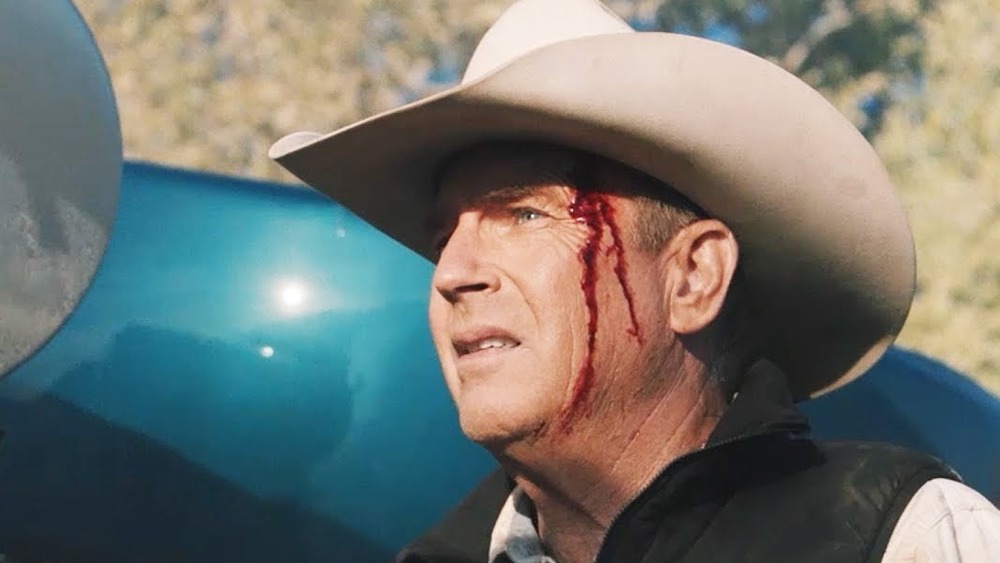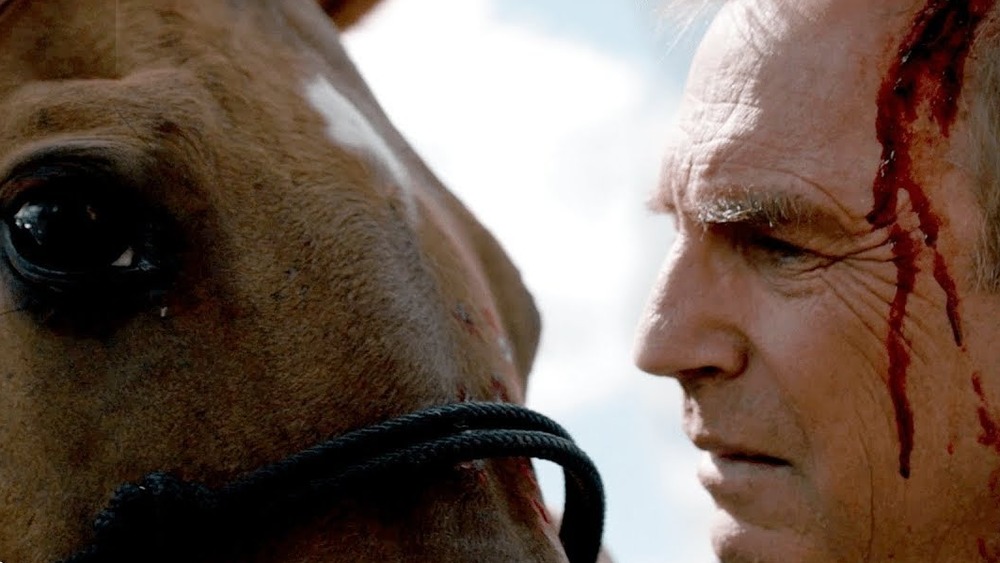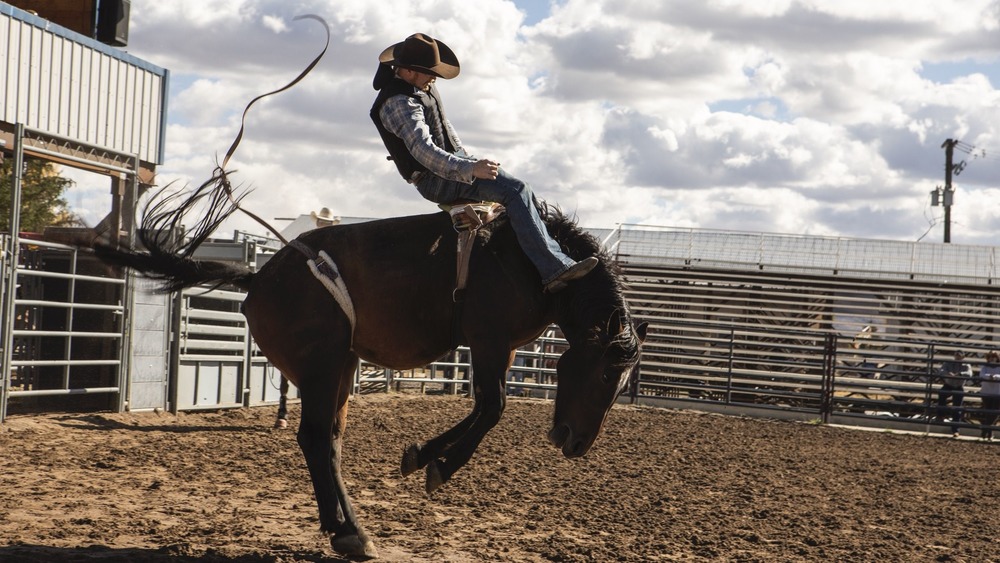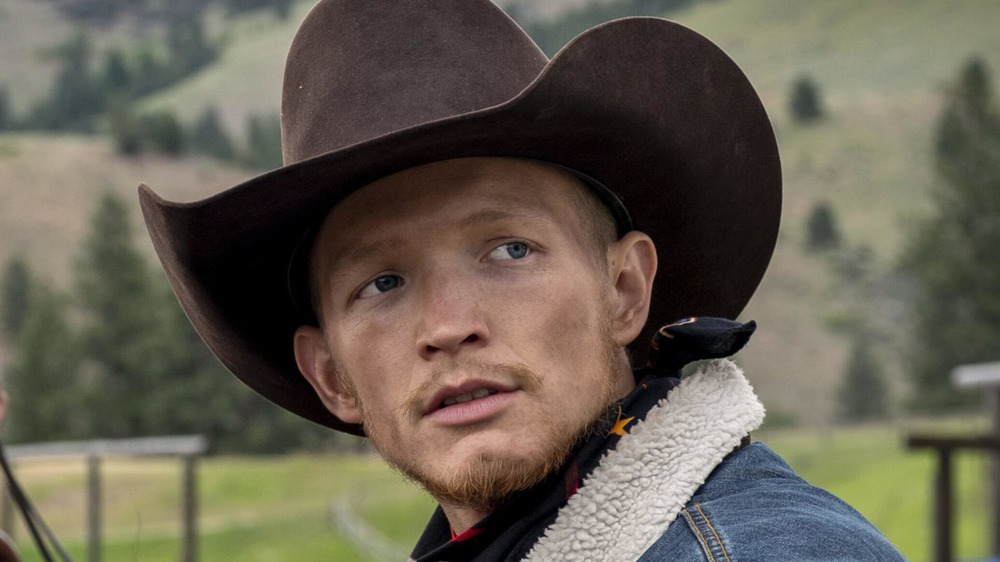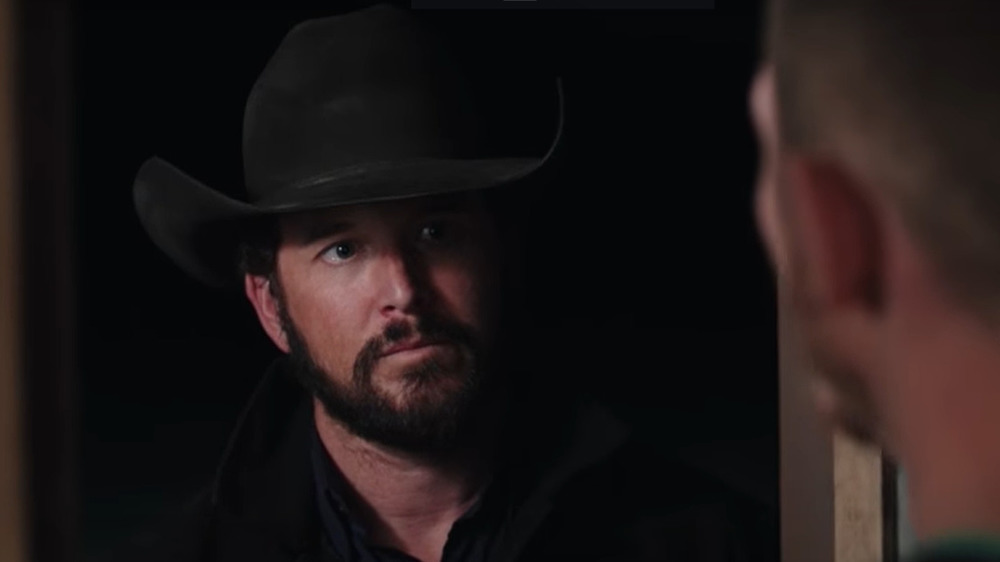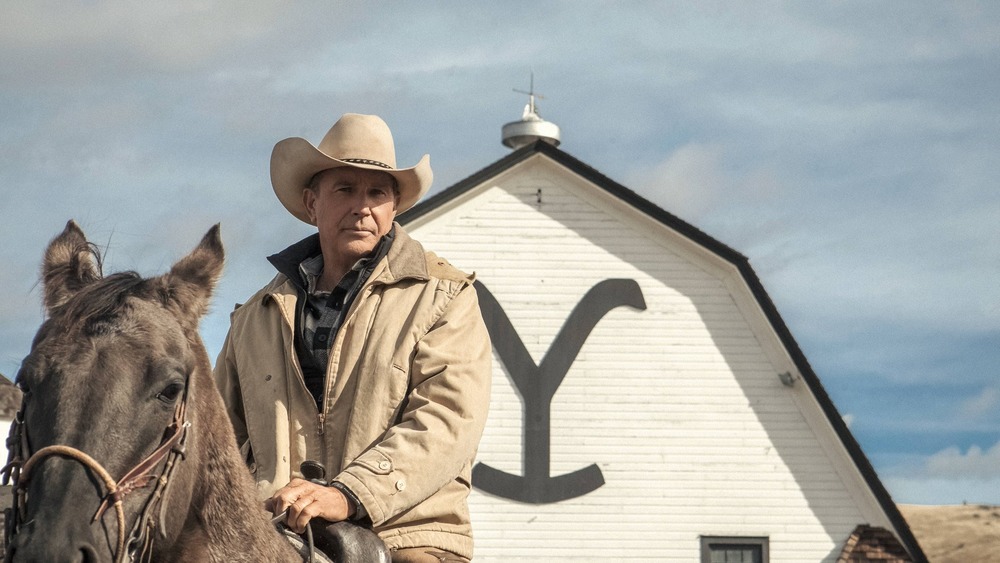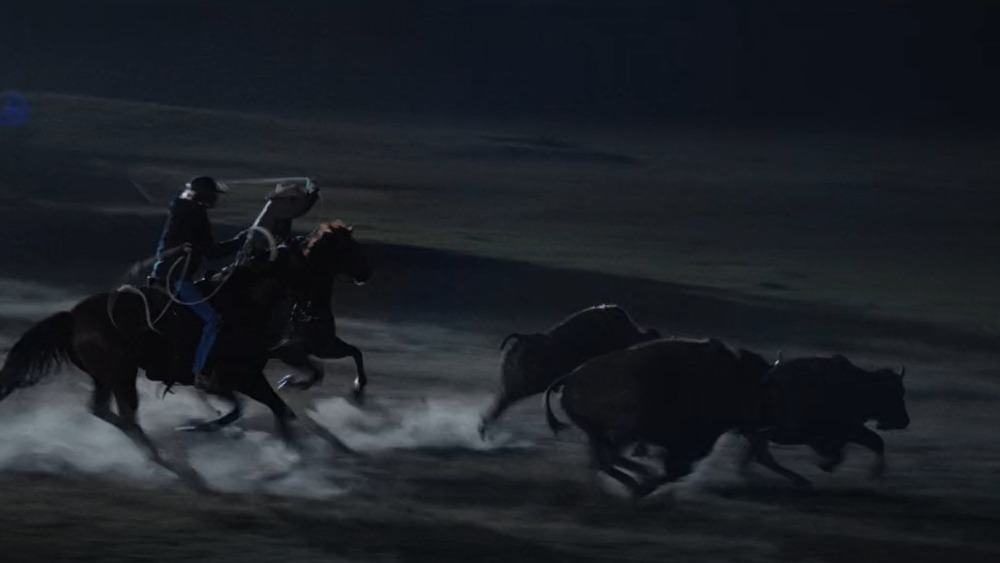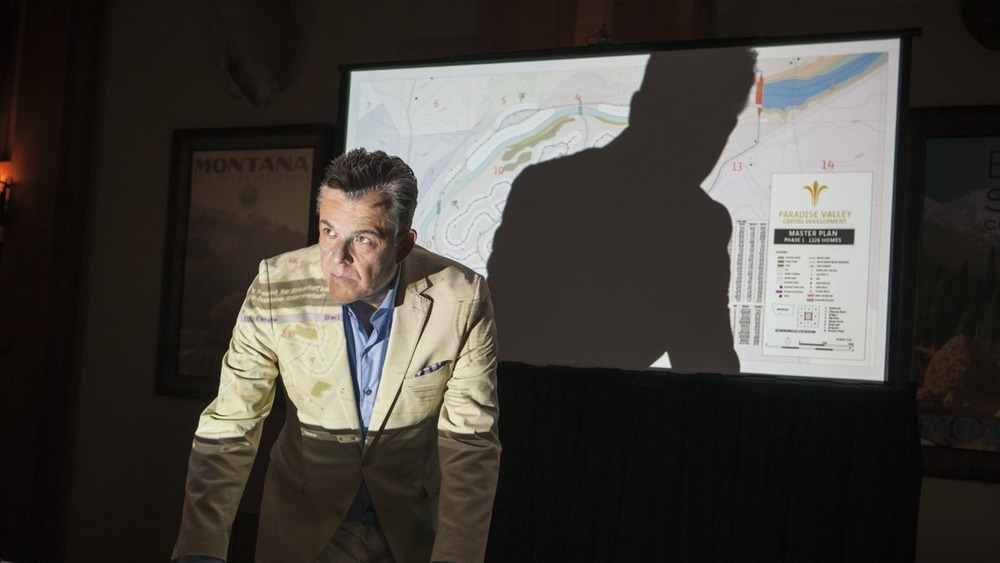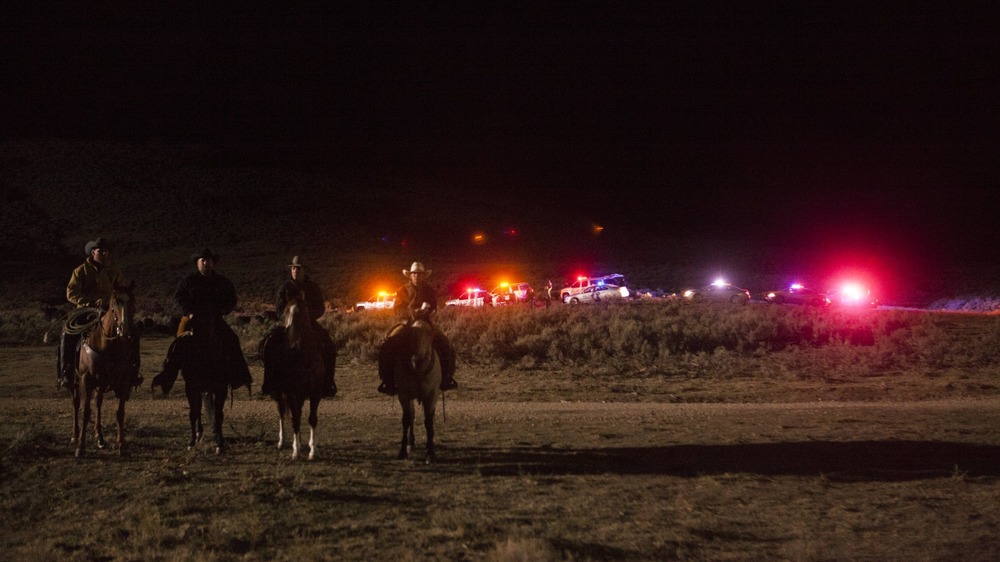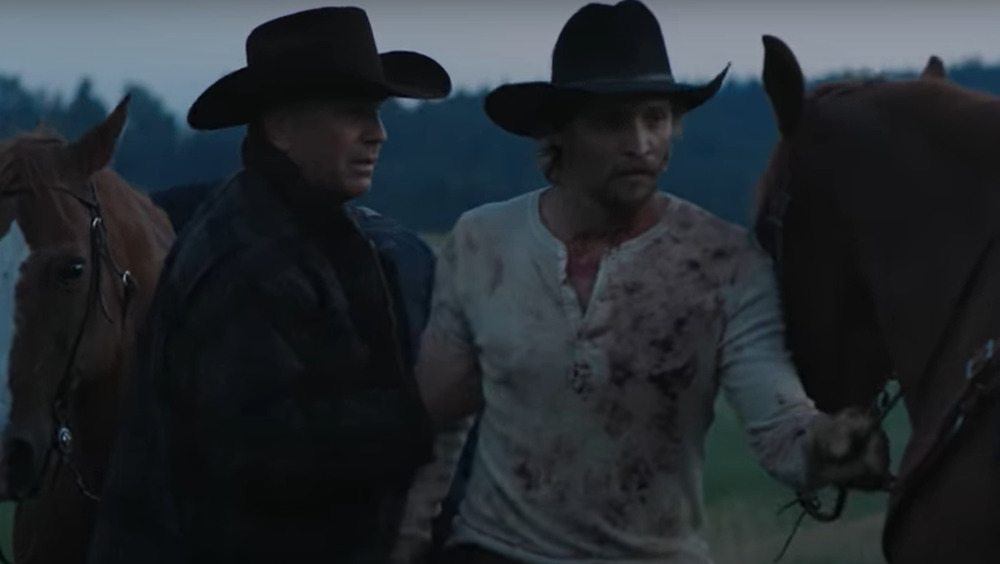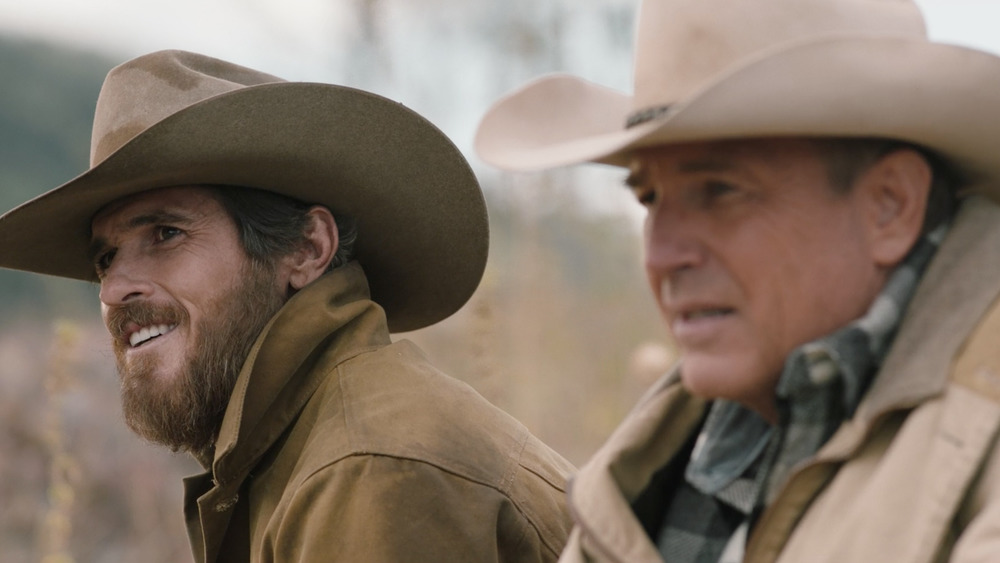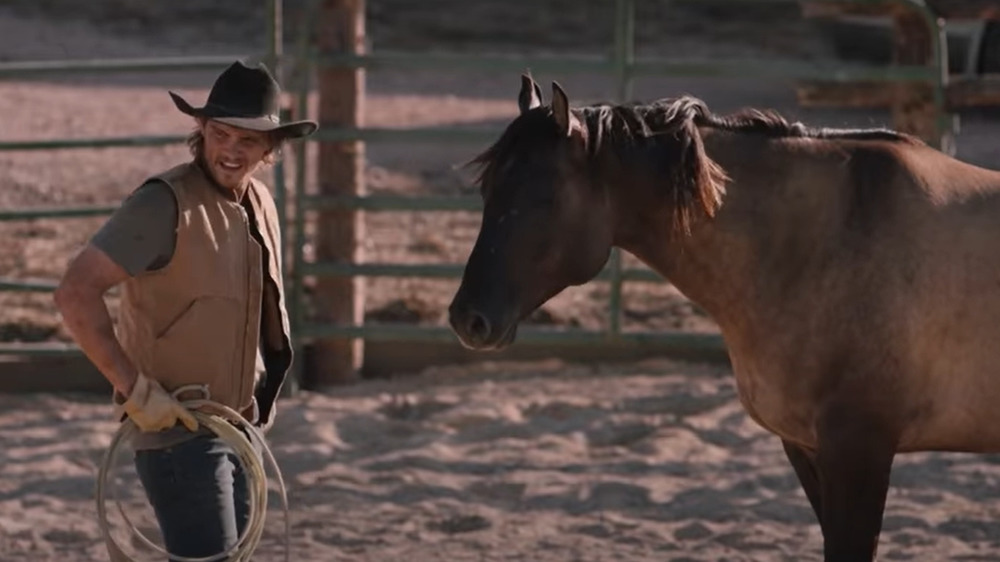Things You Never Noticed In The First Yellowstone Episode
Montana is a land of big skies, jagged mountains, and that most American of icons, the cowboy. The romance of wild lands and tough men on horseback explains why people from all over the world flock to small western towns, why cowboy hats can be seen on the streets of Manhattan, and why Paramount's modern, Montana-set cowboy series Yellowstone has become such a hit.
Yellowstone snagged fans from the very first episode. For one thing, the pilot throws you into a three-way battle that carries through the first two seasons. Moreover, important characters die, huge animals roam the landscape, and tough men make tough decisions. It's a story as old as the West, and still as prescient: There's no clear good guy or bad guy, though there is a family to root for. The Duttons make their entrance in Yellowstone's pilot as well, full of the convoluted, painful, and potent ties the show goes on to explore at length.
Yellowstone's first episode weaves indelible dialogue and truly ugly events together, juxtaposed against a jaw-droppingly beautiful landscape. There's so much packed into this pilot, in fact, that there's a good chance you missed many of its details. Not to worry: We're here to remind you.
The past collides with future
Yellowstone opens with John standing on the side of the road, beside a mangled car wreck. The first time you watch the pilot, you might not notice that the vehicle John has crashed into is pulling a trencher. You might not even know the significance of that particular piece of machinery. A trencher is used for putting in pipelines – this one is probably for putting in all the electrical and water lines for the new development. When you first watch the pilot, however, you don't yet know about Dan Jenkins or his planned neighborhood. As a result, you might not grasp the significance of the moment when John Dutton looks at paperwork from the semi and finds out the man is a driver for the Paradise Valley development.
This all makes sense once you finally learn that Jenkins' plans have advanced to the point of hooking up utilities. This tension results in John Dutton blowing up a hillside to reroute a river, so Jenkins can no longer suck water for free irrigation and electricity. Later, you see Jenkins walking past trenchers in shock at the new rock pile from which a river once flowed. Jenkins may injure John in the opening scene, but it's one of the few wins he gets.
Things we lose to keep you fed
The pilot's opening scene ends with John telling his horse that all he can offer it now is peace. He then shoots the animal, before turning to the cows by the road and saying, "The things we lose to keep you fed." This is basically the theme of the whole series. The Dutton ranch involves so much more than just raising livestock, and yet, that's just what a ranch is: A place to keep cows alive long enough to sell them. The ranch is the cattle, and vice versa. Trade-offs must be made to keep it all afloat, but they're never easy to make.
Throughout the series, serious decisions and sacrifices are made to keep the ranch. Everybody questions, at some point or another, whether it's even worth it. This scene from the pilot, and the theme it embodies, is very specifically referenced in the season three finale in a harrowing way. In that cliffhanger, Rip sees a horse in pain, and has to put it out of its misery before realizing something is wrong. Meanwhile, John bleeds on a roadside, gunned down by would-be assassins. Another John Dutton accident, another dead horse, another brutal sacrifice for the sake of the ranch. Life is tough on the open roads of Montana.
The rodeo question
When John Dutton rides up to Jenkins playing golf, Jenkins mentions how his friend in Jackson Hole, the model for tony gentrification pushing out a ranching past, was talking up their rodeo. Jenkins asks why they don't have one in Bozeman, to which Dutton replies that it's not wanted.
There are a couple things to note here. First, there is a rodeo on Yellowstone, just not in Bozeman. John Dutton ends up visiting a rodeo to meet a local friend and discuss his woes, and later, Jimmy becomes a rodeo star, which leads to an ongoing fraternization with barrel racer girls. Second, there is a rodeo in Bozeman: Several rodeo events, in fact. The difference may be that Bozeman's rodeo isn't like the twice-weekly spectacle held in Jackson Hole, which is a big summer tourist attraction. Still, Dutton is straight-up wrong. Plus, rodeo becomes a pretty central part of Yellowstone as the show goes on.
Dirk asks John for a favor
It's pretty easy to miss the scene where John agrees to take on the hapless Jimmy Hurdstrom. It happens at the livestock auction, where Jimmy's grandfather Dirk sits down next to John and asks for a favor, just before he talks to the governor. John's had a rough week so far and wants to avoid this conversation, but there's obviously some unspoken history that makes him listen to Dirk. Despite saying that he's "looking for cowboys, not criminals," he finally acquiesces, though he says it'll be done his way. Dirk replies that he remembers when John's way was the only way and the world was better for it.
The backstory between John and Dirk is never really explored. The original script describes Dirk as a farmer, which means he wouldn't have necessarily run into a cattleman like John very often, other than to lavish respect on a town dignitary. We do later find out that Dirk's wife died, leaving him with nobody alive and out of jail except Jimmy. This is pretty similar to how the death of John's wife began the Dutton family's decline. This might have been enough to bond the two men. Whatever the reason, only in Montana is a livestock auction a place where folks help prevent recidivism.
Rip the thug
When we first meet Rip, he's forcing his way into Jimmy's house and tazing the kid unconscious. He seems like little more than a hard-hearted golem, and even tells Jimmy that he's either going to jail or taking a Yellowstone Ranch brand. Jimmy is, understandably, afraid of this big man dressed in black who's tied him up and brandished a red-hot piece of iron at him.
Rip and Jimmy's bromance begins here, and it's one of the most touching elements of the bunkhouse. We soon realize that Rip actually runs the ranch, or at least much of the day-to-day, and that he's more unquestioningly loyal and respectful of John than any of the Dutton children. This eventually leads to Rip getting a house of his own on the property. Ultimately, you wouldn't be wrong in saying that Rip is the most caring and compassionate person on the show. But in his first appearance, Rip is downright frightening.
A ranch the size of Rhode Island
Thomas Rainwater chastises John for having a ranch the size of Rhode Island while discussing how the Duttons (and white people in general) have hurt Native Americans. This claim of land size sounds exaggerated, but remember: Rhode Island is a very small state, and Montana is a very big one. Yellowstone National Park itself is bigger than Rhode Island and Delaware combined.
Still, this stated size for Yellowstone Ranch has to be an overstatement, though it is later mentioned that John Dutton could sell 50,000 acres while still possessing most of the ranch. Let's break it down. First off, Rhode island spans approximately 776,000 acres. The largest contiguous ranch in the US is the Waggoner Ranch in Texas, at roughly 535,000 acres. While there are people who own more land — Ted Turner, for example, owns around 2 million acres, including large holdings in Montana — the largest landowners in Montana, the Wilks brothers, have over 300,000 acres. So either Rainwater is exaggerating a lot, or the Yellowstone Ranch has absolutely no real-world basis.
A brief foray into bison ranching
When a herd of bison arrives on the ranch, a hand asks, "What are we supposed to do with those things?" This herd is seen ranging throughout the episode. There's even a scene in which Felix Long is allowed to hunt the beasts, as a sort of homage to the proud Native American hunters of the past. Thomas Rainwater laments this charade as a display of what white settlers have reduced his culture to. Yet Felix Long, who is arguably the wisest and most at-peace human in the series, is fine with it.
Even more notable are the bison themselves. Never again do viewers see the Duttons managing the rambunctious herd — they even get into a fight with Wade later on, for driving the animals near their land. Where'd they go, cowboys? The bisons' mysterious absence in later episodes leaves viewers with many questions.
Dan Jenkins, hypocrite
You can do whatever you want in Montana, Jenkins says: Up here, land ownership is near sacred. "This isn't California, gentlemen," he smugly asserts. But when John Dutton does what he wants on his own land by diverting a river to remove Paradise Valley's water source, Jenkins suddenly cries foul.
This is a hypocrisy that runs through Jenkins' character. He thinks that whatever he's doing is right and justified, since he feels he deserves his piece of the American dream. He's not all that concerned about the dreams and desires of those who came before, of course: He can only really conceive of his dreams and visions being worthy of respect. When the people he's infringing on come back at him, he's shocked and insulted.
This makes it all the more ironic when his dreams are finally taken down — not by John Dutton, but by the Beck brothers in season two. Jenkins even makes a brief alliance with John Dutton and Thomas Rainwater, showing how far from his original pedestal Jenkins has fallen. In the first episode, however, Dan Jenkins still thinks he's a conquering emperor whose dreams will be flawlessly realized.
Rip doesn't join the firefight
Rip is the Dutton Ranch's top hired gun. He's good in a fight, whether it's with a bunch of bikers or part of a mission to get Tate back from a Montana militia. He's reliable, able to keep a cool head, and acts strategically. He would've been great to have on the raid of the reservation, and possibly able to prevent Lee's death. Instead, John has him lead Jimmy in blowing up a hillside to divert his river. Thus, Lee Dutton has to lead some random hands across the line into sovereign lands with a helicopter. He pays the ultimate price for it.
While the hillside bombing builds on the Rip-Jimmy bromance, John definitely misses Rip at the standoff on the reservation. It should be noted that from this point on, there isn't a big battle for the rest of Yellowstone's run that doesn't include Rip. Forever after, Rip has the back of any Dutton heading into danger.
Elk bugling
After the standoff, while the sun rises and John and his people are still looking for Lee, we see a scene of elk crossing a river. We can hear them bugling, which they do in fall, during the rut. This means that subsequent episodes of Yellowstone are set in the fall, which, in turn, means there should be snow at some point. This makes things a little problematic. John going to a rodeo in the following episode, for example, becomes strange, considering the fact that there are no rodeos in Montana around that time of year. Even if there were, they certainly wouldn't take place in an outdoors arena.
Of course, the elk bugling might just be the sort window dressing nobody gave much thought to. It is, after all, a compelling natural sound. Beyond this, however, it contains important symbolism: The elk cross the river just before Kayce returns covered in blood, during the "Daybreak" from which the episode gets its name. It signifies the show's beginning, and reminds the viewer that nature doesn't care about human battles and deaths.
The Montana goldfinch
John brings Lee's body out to rest by a tree, to determine where to bury the boy. It's one of the few scenes in all of Yellowstone where we see John give into the overwhelming grief that defines his life. In the midst of his sadness, John sees a goldfinch land on the ground. He takes that image in and acknowledges it as a sign that he should bury Lee right there. There's never explicit mention of this, however, so you might miss the great relevance of this small animal.
Despite the fact that this is a story about people, nature is utterly central to it. The beautiful mountains, forests, and fields of Montana surround the characters, while the bears, wolves, elk, bison cattle, and horses stride alongside them. It makes sense, then, that John lets a pretty little bird determine where he buries his beloved eldest son. Of all his children, Lee had the closest connection to the animals around him. In many ways, Lee was John's favorite because he was the simplest child. It's only right to honor him in such a powerfully simple way.
Kayce's wild stallion
We first meet Kayce rushing headlong towards a wild stallion that's been disrupting an oil field. When he brings it home to the reservation, the kids are quickly captivated by the animal. John comes to visit as Kayce is trying to tame the horse. John mentions how Kayce needs to break the animal for it to serve him better, and Kayce replies that a horse doesn't need to be fully broken to be good. This is a heartbreaking back-and-forth full of buried meaning, though it's easy for the first-time viewer to miss.
Later, Kayce rides the horse into the firefight. Eventually, he brings the wild stallion as a gift for John, a first step toward their eventual reconciliation. He mentions how the horse has a lot of heart, and would have died for him. Furthermore, in the second episode, Jimmy gets taped to the horse to break it. This leads John to say that Jimmy might have some cowboy in him, which leads Jimmy to a rodeo career.
Eventually the horse becomes an excuse for John to ask Kayce to come back to the ranch. A wild, impressive animal that changes the lives of everybody it touches? Sounds a little like Kayce himself.
